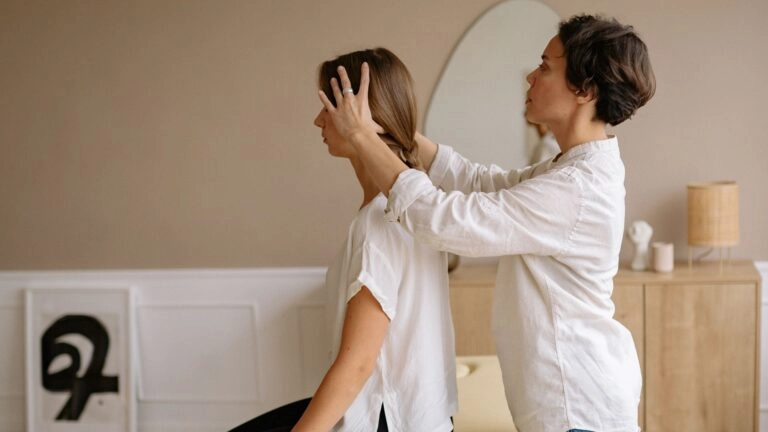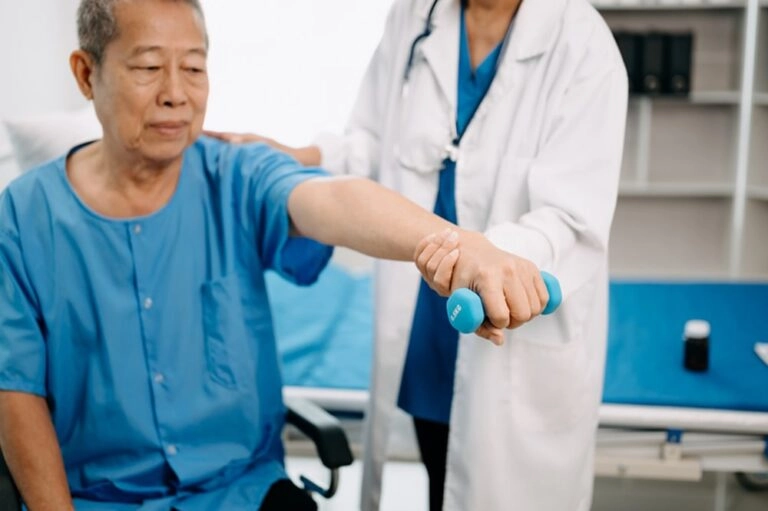Do you suffer from spondylolisthesis? Are you having difficulties sitting because of excruciating back pain? Keep reading for some useful tips you can use.
The key to sitting with spondylolisthesis is to maintain correct posture. To that end, you can follow these tips to alleviate some of your pain: keep your spine in a neutral position, develop a physical therapy/exercise routine, wear a back brace to support your spine, and/or use ergonomic devices to support your posture.
Sitting with Spondylolisthesis
Spondylolisthesis is a condition in the spine where a vertebra slips out of its normal position. This happens most frequently in the lower back, but not exclusively so. It can happen in the neck and the upper back as well.
A common difficulty with spondylolisthesis is finding a comfortable sitting position. That is not uncommon with spinal issues. Whether you are looking for tips for sitting with a herniated disc or spondylolisthesis, we can help. Spondylolisthesis often causes back pain. Sitting improperly when you have spondylolisthesis can aggravate the pain and exacerbate the condition. Here are a few tips to help you sit with spondylolisthesis:
1. Keep Your Spine in a Neutral Position
Like many musculoskeletal issues, a key factor in spondylolisthesis is posture. Poor posture has a tendency to aggravate many different spinal conditions including spondylolisthesis. In contrast, correcting your posture and maintaining such can help ease the pain and other difficulties spondylolisthesis can cause.
You want to support and maintain your spine’s natural ‘S’ shape by sitting up straight, keeping your feet flat on the floor, and your hips tilted forward. Sitting consistently with correct posture will go a long way in alleviating your pain.
2. Develop a Physical Therapy/Exercise Routine
One way of treating Spondylolisthesis is through physical therapy and exercise. As noted above, correct posture is critical when dealing with musculoskeletal issues like spondylolisthesis.
In light of that, many physical therapists will prescribe a set of PT exercises for their patients to do that will strengthen muscles that surround and support the spine in key areas. Strengthening such muscles will, over time, reduce slouching and improve the overall posture of the individual in question.
3. Wear a Back Brace for Support
Another option for a patient suffering from spondylolisthesis is to wear a back brace to keep your spine in proper posture while you are sitting. This may be particularly necessary if you, like many other people, work behind a desk and, so, find yourself sitting for much of the day.
A back brace will physically prevent you from slouching or slumping and thereby distorting the natural ‘S’ shape of your spine. However, realize that the more your muscles rely on the brace, the less work they have to do to keep your spine aligned properly. In time, this might lead to weakening of those muscles unless you take other steps (like exercises) to strengthen them.
4. Use Ergonomic Devices To Help You Sit Properly
Advances in science have given us a better understanding of the human body, the musculoskeletal system, posture, and the spine. As a result a number of ergonomic devices have been developed to assist patients with spondylolisthesis or other ailments to keep their spines in a neutral position while sitting. These devices include:
- Ergonomic Chairs: these chairs are specially designed for providing comfort while, at the same time, keeping you in correct posture. Normally, ergonomic chairs provide special support to your bottom, and your back.
- Ergonomic Cushions: these cushions include lumbar cushions and ergonomic wedge cushions. Although these cushions do not support the whole of the back, they provide specialized support to your bottom that “encourages” a natural, neutral, alignment of the spine.

The Science of Spondylolisthesis and Chiropractic Care
If you have misgivings about chiropractic care, as some people do, let’s put your fears to rest. Let’s look at the science, specifically, the effectiveness of chiropractic care on spondylolisthesis.
Science Direct published this case report on a 57-year-old man who was suffering from low back pain and other symptoms of lumbar disk injury, spondylolisthesis, and spondyloptosis. His condition was successfully treated with chiropractic spinal manipulation, physical therapy modalities, and rehabilitative exercises.
The National Library of Medicine reports the following case from The Journal of Canadian Chiropractic Association. In this instance, the patient suffered from degenerative spondylolisthesis and was successfully treated with spinal manipulative therapy.
As you can see, chiropractic care can be effective in treating spondylolisthesis.
Chiropractic Care and Spondylolisthesis
When it comes time to decide on a course of treatment, it is good to remember that there are non-surgical treatments for spondylolisthesis. And, as a general rule, it is usually best to start with conservative, natural, non-invasive therapies first before moving on to the heavy-hitting therapies like surgery or the really potent prescription painkillers.
Who would want to undergo risky surgery, if chiropractic care would do the trick?
Chiropractic care is non-invasive, natural and doesn’t disrupt your life. By using low-force chiropractic manipulation combined with flexion-distraction therapy, a chiropractor may be able to help the spondylolisthesis patient’s slipped vertebra back into its proper position. Of course, this may take multiple chiropractic visits to complete, but you won’t be confined to a bed to recover like you would with surgery.
This is true for not only spondylolisthesis, but other spinal conditions as well. Chiropractic care for spondylosis (arthritis of spine) is also effective as is chiropractic care of lumbago (a type of back pain).
Conclusion
We hope you find these tips on how to sit with spondylolisthesis useful and effective. As always, though, when dealing with a medical condition, it is best to incorporate exercises and therapies into your life under the guidance of a medical professional – like a chiropractor, a physical therapist, or, even, a medical physician.
Sources:









